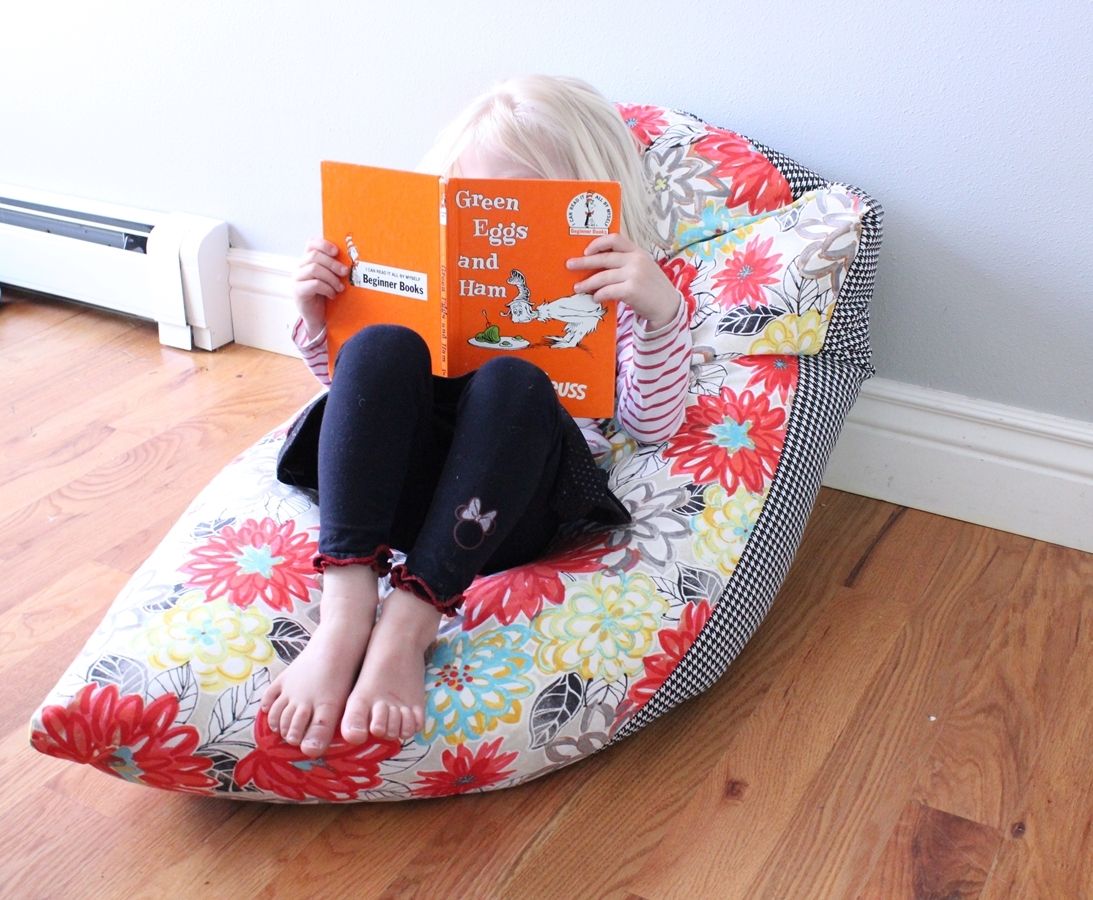Materials and Tools
:max_bytes(150000):strip_icc()/DropclothBeanbagChair8-50f28c97b1b2436f8aa37f8fc2159aa7.jpg)
Creating a bean bag chair is a fun and rewarding project, and you’ll need a few essential materials and tools to get started. This section will guide you through the necessary materials and tools, ensuring you have everything you need for a comfortable and stylish bean bag chair.
Fabric
The fabric you choose will greatly impact the look and feel of your bean bag chair. Consider these factors:
- Durability: Choose a fabric that can withstand wear and tear, especially if you plan to use the bean bag chair frequently.
- Comfort: Opt for a fabric that feels soft and comfortable against your skin.
- Water Resistance: If you’re concerned about spills or accidental splashes, consider a water-resistant fabric.
- Style: Choose a fabric that complements your personal style and the overall aesthetic of your home.
Here are some popular fabric choices for bean bag chairs:
- Canvas: Durable and affordable, canvas is a good option for a classic bean bag chair. It’s available in a wide range of colors and patterns.
- Cordura: This nylon fabric is incredibly strong and resistant to tears and abrasions. It’s often used for outdoor furniture and is a good choice for high-traffic areas.
- Microfiber: Soft and comfortable, microfiber is a popular choice for bean bag chairs. It’s also stain-resistant and easy to clean.
- Velvet: Adds a touch of luxury and sophistication to your bean bag chair. Velvet is soft and plush, but it may require more delicate care.
Filling
The filling determines the firmness and comfort of your bean bag chair. Here are some common filling options:
- Polystyrene Beads: The most common type of bean bag filling, polystyrene beads are lightweight, affordable, and provide a comfortable, moldable seating experience.
- Microbeads: Smaller than polystyrene beads, microbeads offer a softer and more conforming feel. They are often used in bean bag chairs designed for children or those seeking a more delicate seating experience.
- Recycled Foam: An eco-friendly alternative to polystyrene beads, recycled foam provides a firmer and more structured seating experience. It’s also a good choice for those who are sensitive to polystyrene.
- Cotton Beans: Natural and biodegradable, cotton beans offer a unique texture and a more traditional feel. However, they may be more prone to clumping and require more frequent fluffing.
Sewing Supplies
You’ll need a few essential sewing supplies to create your bean bag chair:
- Sewing Machine: A sewing machine will make the process much easier and faster.
- Sewing Needles: Choose needles that are appropriate for the fabric you’re using.
- Thread: Match the thread color to your fabric or choose a contrasting color for a decorative touch.
- Scissors: Sharp scissors are essential for accurate cutting.
- Measuring Tape: A measuring tape will help you accurately cut the fabric to size.
- Pins: Pins will help secure the fabric while you’re sewing.
- Zipper: A heavy-duty zipper is essential for closing the bean bag chair and allowing you to easily add or remove filling.
Tools
In addition to sewing supplies, you’ll need a few tools to complete your bean bag chair project:
- Fabric Marker: A fabric marker will help you mark the fabric before cutting.
- Iron: An iron will help you press the seams and create a professional finish.
- Sewing Machine Foot: A zipper foot will make it easier to sew the zipper onto the fabric.
- Heavy-duty Sewing Needle: If you’re hand-sewing, you’ll need a heavy-duty needle to handle the thick fabric.
Construction and Assembly

Now that you have all the materials and tools ready, it’s time to get your hands dirty and bring your bean bag chair to life! We’ll guide you through each step, from sewing the fabric panels to filling it with the cozy comfort you deserve.
Sewing the Fabric Panels
Before starting, lay out all your fabric panels and ensure they are cut to the right size. The panels will be sewn together to create the bean bag’s outer shell.
- Pin the panels together, right sides facing. Use plenty of pins to hold them in place while you sew.
- Sew along the edges of the panels, using a strong, durable thread. Leave a gap of about 6 inches for the zipper.
- Turn the fabric right side out and press the seams flat.
Attaching the Zipper
A sturdy zipper is crucial for easy access to fill and clean your bean bag chair.
- Place the zipper on the open edge of the fabric, with the zipper teeth facing the inside of the bag.
- Pin the zipper in place, making sure it’s centered and aligned with the seam allowance.
- Sew the zipper to the fabric, using a zipper foot on your sewing machine.
- Once the zipper is attached, test it to ensure it opens and closes smoothly.
Filling the Bean Bag Chair
Now comes the fun part! Fill your bean bag with the chosen filling material.
- Start by filling the bean bag about halfway.
- Sit on the bean bag to distribute the filling evenly.
- Continue adding filling until you achieve the desired firmness and comfort.
- Remember to leave some space at the top to allow for the zipper to close properly.
Bean Bag Chair Designs and Construction Techniques
There are countless designs for bean bag chairs, each with its unique construction technique. Here’s a table showcasing some popular designs and their corresponding construction methods:
| Bean Bag Chair Design | Construction Technique |
|---|---|
| Classic Bean Bag Chair | Sewing fabric panels together, attaching a zipper, and filling with beans or foam pellets. |
| Oversized Bean Bag Chair | Similar to the classic design, but using larger fabric panels and more filling material. |
| Bean Bag Chair with Arms | Sewing additional fabric panels to create armrests. |
| Bean Bag Chair with a Backrest | Sewing a separate backrest panel and attaching it to the main body of the bean bag. |
Customization and Design: How To Make A Bean Bag Chair

How to make a bean bag chair – Once you’ve mastered the construction of your bean bag chair, it’s time to unleash your creativity and personalize it to reflect your unique style. From fabric choices to structural modifications, the possibilities are endless. Let’s dive into the exciting world of bean bag chair customization and design.
Fabric Choices
The fabric you choose for your bean bag chair is the most visible element of its design, influencing both its aesthetic appeal and functionality. A wide range of fabrics, each with its own advantages and disadvantages, are available.
- Microfiber: This soft, durable fabric is a popular choice for bean bag chairs. It’s easy to clean and comes in a wide variety of colors and patterns.
- Cotton: A natural and breathable fabric, cotton is comfortable and soft. However, it may wrinkle easily and can be more prone to stains.
- Polyester: This synthetic fabric is known for its durability and resistance to fading. It’s also relatively easy to care for and comes in a wide range of colors.
- Leather: Leather adds a touch of luxury and sophistication to any bean bag chair. It’s durable and ages beautifully, but can be expensive and requires regular maintenance.
- Velvet: For a luxurious and elegant look, velvet is an excellent choice. It’s soft and plush, but can be more difficult to clean than other fabrics.
Shapes and Sizes
Bean bag chairs are available in a variety of shapes and sizes, allowing you to find the perfect fit for your needs and space. From classic round shapes to innovative designs, let’s explore the options.
- Round: The traditional round bean bag chair is a classic and comfortable choice. It’s versatile and can fit in various spaces.
- Square: Square bean bag chairs offer a more structured look and can provide additional support for your back.
- Bean Bag Beds: For ultimate relaxation, consider a bean bag bed. These large, oversized bean bags provide ample space for lounging and sleeping.
- Other Shapes: Innovative designs are constantly emerging, offering unique shapes like pear, teardrop, or even bean bag ottomans.
Custom Features, How to make a bean bag chair
Take your bean bag chair to the next level by incorporating custom features that enhance comfort, functionality, and style.
- Built-in Pockets: Add convenient storage pockets for your remote control, phone, or other essentials.
- Armrests: Armrests provide extra support and comfort, making your bean bag chair even more inviting.
- Headrests: For ultimate relaxation, incorporate a headrest for neck support and comfort.
- Zippers and Removable Covers: Zippers allow you to easily remove and wash the cover, keeping your bean bag chair clean and fresh.
Design Examples
Let’s explore some inspiring examples of bean bag chair designs and their unique advantages and disadvantages.
- The Classic Round Bean Bag: This timeless design offers comfort and versatility. Its simplicity allows it to blend seamlessly with various decor styles. However, it may not provide optimal back support for extended periods.
- The Bean Bag Bed: Perfect for lounging and sleeping, the bean bag bed offers spacious comfort and a unique, relaxed feel. However, its size may make it unsuitable for smaller spaces.
- The Bean Bag Chair with Built-in Pockets: This practical design combines comfort with convenience, offering storage space for essentials. However, the pockets may add bulk to the chair.
- The Bean Bag Chair with Armrests: This design enhances comfort and support, making it ideal for reading or watching TV. However, the armrests may limit the chair’s versatility for different seating positions.
The comfort of a bean bag chair, a haven of soft, yielding embrace, reminds me of simpler days. Perhaps, a more suitable haven for a beach day would be a telescope beach chair with canopy , offering shade and a sturdy frame to rest against the sand.
While the bean bag might be a cozy refuge for a quiet afternoon, a sturdy beach chair evokes memories of sun-drenched days and the gentle rhythm of waves, a constant reminder of the fleeting nature of time.
The process of crafting a bean bag chair is a soothing, meditative act, much like watching the tide roll in on a quiet beach. Perhaps that’s why the comfort of a serena and lily beach chair resonates so deeply with me.
They both offer a sense of calm and retreat, a haven from the everyday. As I carefully stitch together the fabric for my bean bag, I dream of a similar sense of serenity, a sanctuary to escape into when the world feels too much.
